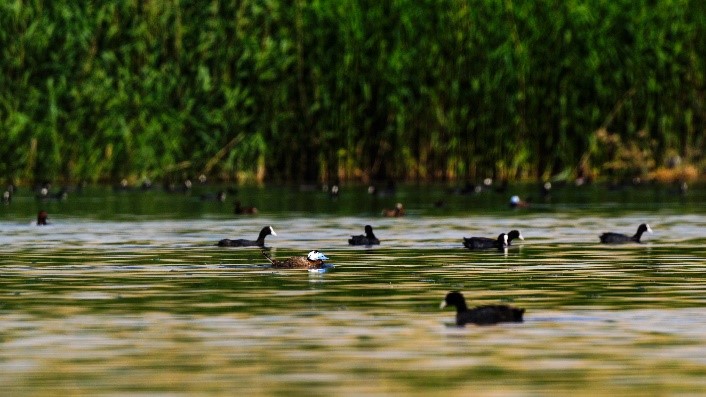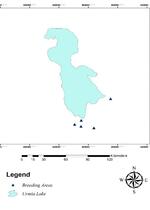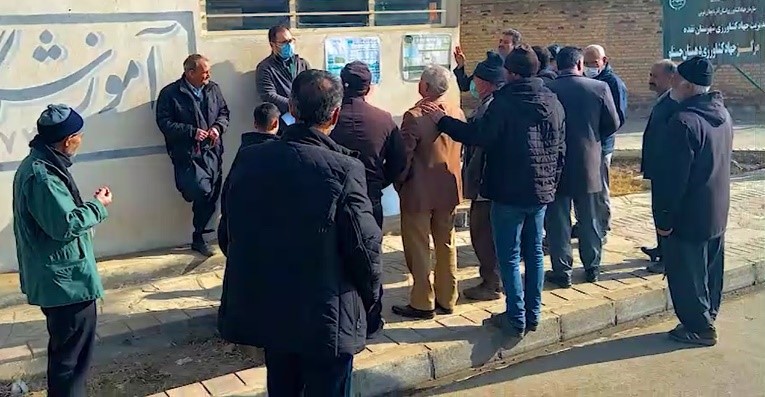The wetlands around Iran's Lake Urmia, one of the most important habitats for breeding of white-headed ducks
Lake Urmia is one of the largest inland lakes located in northwestern Iran. This vast hyper-saline lake is a Ramsar Site, a UNESCO Biosphere Reserve and a National Park.
The White-headed Duck (Oxyura leucocephala) is listed as an endangered species on Red List by the International Union for Conservation of Nature (IUCN), and are under threat from a range of factors - including lack of water supply sources, human activities such as poaching and fishing, and pollutants entering the wetlands.
Urmia Wetland and its ecosystem
Iran is situated in a geographically unique area, with diverse climatic conditions and rich biodiversity. This situation has made 41 wetland types available in Iran out of a total of 42 types that can be observed all over the world.
The catchment area of Lake Urmia in northwestern Iran includes a number of wetlands that are important and significant in terms of environmental, social, and economic value. The complex of these wetlands includes the large and extremely salty lake of Urmia and about 30 salty-sweet water surrounding wetlands, seven of which are of special importance. Some of these wetlands are part of the Ramsar Convention and are of international importance, while others are registered as national protected areas.
Unfortunately, in recent years, Lake Urmia has been shrinking at an alarming rate and a considerable part of its area has been lost. A range of users in the basin regularly over-extract water sources of the lake, resulting in a situation wherein the outflow has vastly exceeded the inflow in recent years. This has been exacerbated by an ongoing drought.
As a result, Lake Urmia is facing the threat of turning into an irreversible situation where the dimension of its impacts would gradually spread from biodiversity to socioeconomics, affecting the health and livelihoods of the surrounding communities.
White-headed duck and its breeding population habitats in Urmia wetlands
Waterbirds are indicators of wetland biodiversity and the positive ecological role of these species in the survival of other aquatic ecosystems has long been known (Furness & Greenwood, 1995). Therefore, it is obvious that by eliminating and reducing their population in wetland ecosystems, the survival of other species will be threatened. Therefore, it is necessary to study their reproduction, identify the threat factors and the success of reproduction, and determine the habitat quality for breeding.
 White-headed Duck and its habitat in Hasanlu wetland
Photo: Reza Mohammad Pour
White-headed Duck and its habitat in Hasanlu wetland
Photo: Reza Mohammad Pour
 White-headed Duck and its habitat in Hasanlu wetland
Photo: White-headed Duck and its habitat in Hasanlu wetland
White-headed Duck and its habitat in Hasanlu wetland
Photo: White-headed Duck and its habitat in Hasanlu wetland
Figure No.1: White-headed Duck and its habitat in Hasanlu wetland (photos by Reza Mohammad Pour)
The White-headed Duck belongs to the order of Anseriformes and the family of Anatida, with the scientific name of Oxyura leucocephala (Figure No.1). This duck is listed as an endangered species on Red List by the International Union for Conservation of Nature (IUCN). The global distribution of white-headed ducks is limited to the western Palearctic region. It is distributed from Spain and Morocco in western Europe to western China and western Mongolia, and in the north of Iran to southern Russia.
Expert reports and observations in recent years confirm the presence of this species in the wetlands along Lake Urmia, including Hasanlu and Durge Sangi, Kani Barazan, Soldouz, and Qareh Qeshlagh. These wetlands are the most important habitats for nesting and breeding of this species (Map No.1).
White-headed ducks are birds that depend on wetland ecosystems and feed on fish, plants, crustaceans, and insects. As they are located in the top of the food chain of wetlands, any ecological changes in wetland ecosystems would cause fluctuations in the population of these birds and thus threaten the survival of other species and the life of wetlands.
 The habitats for nesting and breeding of the White-headed Duck
Photo: Dr. Jalal Henareh, Dr. Mina Esteghama
The habitats for nesting and breeding of the White-headed Duck
Photo: Dr. Jalal Henareh, Dr. Mina Esteghama
The project “Protecting the White-Headed Duck Population in The Hasanlu Naqadeh Wetland Through the Participation of Local Communities” has been accomplished with the support of UNDP and the Iranian Department of Environment (DoE) under the “Conservation of Iranian Wetland Project”, and as a sub-project of "Cooperation in reviving Lake Urmia with the participation of local communities in establishing sustainable agriculture and biodiversity protection" in West Azerbaijan, Iran.
The main objectives of this project are:
- Achieving the desired population status along with protection and sustainability of white-headed duck breeding habitat through participation of the target stakeholders and specifically the local communities;
- Developing an integrated action plan to protect and increase the species population, taking into account: the current status of the hatchery habitats of this species in the neighboring wetlands of Lake Urmia; conflicts and priorities; diversity of natural, economic and social conditions and other factors affecting conservation measures in the range of distribution of this species for the breeding period.
According to studies on the habitat and breeding of white-headed species in Hasanlu wetland and dialogs with key stakeholders and communities living in the margins of the wetland (Figure No.2), it seems that: Environmental stresses due to lack of wetland water supply sources in dry seasons; Poaching and the presence of fishermen in the habitat and easy access to the nests; and Habitat destruction due to unsustainable development factors and the entry of pollutants into the wetland are among the factors that threaten this species and its habitat.
The results of the project emphasise the need for more monitoring and evaluation of the wetlands around Lake Urmia, which are known as waterbirds habitat in the breeding season. Since less attention has been paid to these wetlands as suitable habitats of wildlife, it is necessary to define a level of protection for sensitive areas so that DoE of Iran can cover these areas in the form of conservation programs.
 Participatory approach in dialogue with the community
Photo: Dr. Jalal Henareh, Dr. Mina Esteghama
Participatory approach in dialogue with the community
Photo: Dr. Jalal Henareh, Dr. Mina Esteghama
 %3Cp%3EParticipatory%20approach%20in%20dialogue%20with%20the%20community%3C%2Fp%3E%0A
Photo: Dr. Jalal Henareh, Dr. Mina Esteghama
%3Cp%3EParticipatory%20approach%20in%20dialogue%20with%20the%20community%3C%2Fp%3E%0A
Photo: Dr. Jalal Henareh, Dr. Mina Esteghama
Figure No.2: Participatory approach in dialogue with the community
The project also provided the possibility of establishing the necessary communication between the local community and relevant government organisations in future planning by forming a CBO from the trustees of the villages along the Hasanlu wetland. This action tried to acquaint the local communities with the value of white-headed duck and the importance of its reproduction in the wetlands around Lake Urmia, so that sustainable participatory protection can be done through local communities, along with the various sources of income and livelihood that this protection can bring to them, such as ecotourism and bird watching sites.
Guest post by:
Dr. Jalal Henareh, Dr. Mina Esteghamat
Center for Conservation and Development of Sustainable Ecosystems (ZIPAK NGO)



